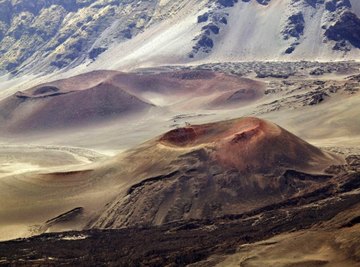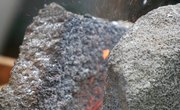
Cinder cones are the most common and widespread type of volcano. This type of volcano is smaller than the less-common shield volcanoes and stratavolcanoes, and may even be found on the slopes near the edges of larger volcanoes. Besides being smaller, cinder cones tend to have a different shape from other volcano types. This type of cone has steep, straight sides and a large crater at the summit.
Chemical Composition
Most cinder cones form through eruption of lava of basaltic composition, although some form from lava. Basaltic magmas crystallize to form dark rocks containing minerals that are high in iron, magnesium and calcuim but low in potassium and sodium. Andesitic magmas crystallize into rocks containing minerals in which all five elements (iron, magnesium, potassium, calcium and sodium) are present in similar amounts. Andesitic magmas are also richer in silicon than basaltic magma.
Physical Composition
Cinder cones are created by relatively small eruptions of pasty, viscous lava. The pressure buildup needed to eject thicker lava tends to create small explosive eruptions instead of flowing lava. These explosive eruptions throw droplets of lava into the air, where they cool and fall back to earth as cinders, or "tephra." The cinder cone grows as successive eruptions pile more cinders on its slopes.
Cinder Cone Examples
CInder cone volcanoes occur around the world, and range in size from a few feet tall to thousand-foot cones. A large and well-known example in the United States is Sunset Crater near Flagstaff Arizona; there are also many small cinder cones around Crater Lake, Oregon. Active cinder cone volcanoes include Mt. Etna in Italy and Paracutin, near Mexico City.
Volcano Types
Cinder cones are the most common of the three principal types of volcanoes. Composite volcanoes (also called stratavolcanoes) are much larger, cone-shaped mountains built of a mixture of layers of ash, tephra and lava. Examples include Japan's Mt. Fuji and several prominent peaks in the Cascade Mountains of the Pacific Northwest. Shield volcanoes, such as Kilauea and Mauna Loa in Hawaii, are broad, gentle cones that can cover huge areas. Shield volcanoes are made almost entirely of lava flows.
Scientists who study volcanoes also recognize a fourth principal volcano type, the lava dome. These small features often form in the crater or on the slopes of a composite volcano. Perhaps the best-known examples of lava domes are the Lassen Peak and Mono domes in California and Mt. Pelée on the Caribbean island of Martinique.
References
About the Author
Kelvin O'Donahue has been writing since 1979, with work published in the "Arizona Geological Society Digest" and "Bulletin of the American Association of Petroleum Geologists," as well as online. O'Donahue holds a Master of Science in geology from the University of Arizona, and has worked in the oil industry since 1982.
Photo Credits
Thinkstock/Comstock/Getty Images
